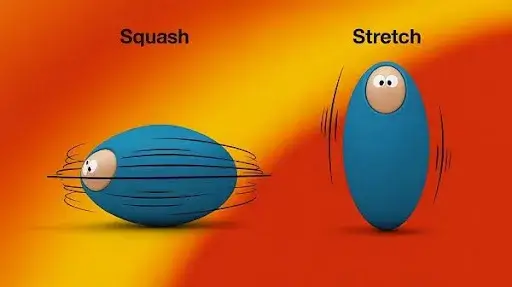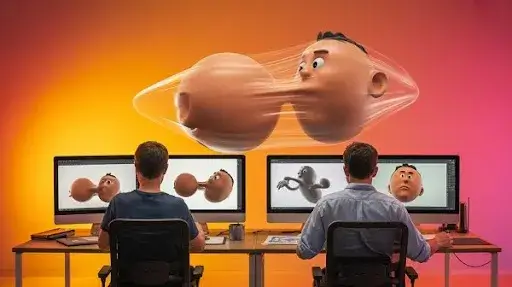Every top-notch animation possesses an unseen pulse, a feeling that defies articulation. It is not solely the motion; it is the cadence, the resonance, the breath. Those impressions, the simulation of life, do not arise from advanced technology or effects. It stems from a sleepless principle that forever altered the approach of animation storytellers: squash and stretch.
From the hand-drawn animation of old Disney shorts to the work of Pixar and beyond, this principle provides elasticity and bounce to otherwise stale, imitative movements. The integration of this concept enables the conversion of two-dimensional, flat, and lifeless imitative movements into spontaneous, believable, and alive ones.
The principle of motion elasticity and spontaneous movement and life is something that, for the most part, has not been recognized and is the most powerful principle in animation.
But squash and stretch aren’t just a neat trick. It’s what gives animation its heartbeat. Let’s take a closer look at how this principle began, and why it still defines the way great animation feels today.
What Is Squash and Stretch?
In the simplest terms, squash and stretch is about how a shape reacts to energy. When something squashes, it’s compressed by force. When it stretches, it’s pulled by motion. These tiny shifts in form say a lot about an object’s weight, speed, and texture, even its attitude.
Picture a ball hitting the ground. It flattens for a blink, that’s the squash. Then it bounces upward, a little taller and thinner, that’s the stretch. No sound, no effects, yet your brain instantly understands the energy behind it.
That’s why animators call it the foundation of believable movement. Take it away, and everything starts to feel stiff and mechanical.
The Power Behind the Motion
Every bit of movement is a quiet tug-of-war between gravity and energy. Squash and stretch capture that tug visually. They mimic real-world physics, not through numbers, but through feeling.
And it is not only in the physical context but also in the emotional sphere. The animated characters possess and exude a profound sense of feeling and sentiment. A character animated with the principles of squash and stretch first extends in a position of surprise and then deflates heavily is expressing and communicating without a single word.
To us, squash and stretch at Prolific Studio is a language; speaking through each frame, profound, purposeful, and animated.
The Evolution of a Game-Changing Idea
Animation was charming during the 1930s, but also awkward. Characters moved without fluidity, without bounce. This was the era of Disney animation. Frank Thomas and Ollie Johnston, animated legends, went through the process of reshaping and bending forms, trying to mimic the functionality of movement and the reaction of forms to movement.
This was the start of one of the 12 Principles of Animation. To improve animation, it first needed squash and stretch. Disney characters could finally have life. Mickey Mouse was able to bounce, Goofy was able to wobble, and Snow White was finally able to glide.
As the art evolved, from hand-drawn frames to 3D animation services and motion graphics, the principle never left. The rule was simple: exaggerate, but keep the volume consistent. That balance keeps motion believable even when the forms distort dramatically.
Why the Significance of Squash and Stretch Still Prevails
The principles of motion, elasticity, spontaneous movement, and life in animation have not changed. The most advanced technology today, motion capture, hyper-realistic rendering, and AI-driven puppets, only enable the creation of lifeless movement and not animated performance.
Animation isn’t meant to copy real life; it’s meant to heighten it. The sweet spot lies between physics and imagination. Take away the stretch from a jump, and it feels robotic. Remove squash from a landing, and it feels empty. When both exist in harmony, the viewer feels the weight, impact, and emotion without ever thinking about it.
That’s the invisible difference between animation that looks good and animation that truly connects.
Breaking Down the Dynamics
Squash: The Impact
Squash happens at the moment of contact. The form flattens slightly, spreading out to show pressure. It’s what tells you, “this object has mass.” The important thing is to keep the volume consistent, wider, yes, but not thinner in substance.
Stretch: The Energy
Stretch shows the release. It’s the leap, the recoil, the snap that follows impact. It tells the audience how fast and fluid something moves. A bit too much stretch looks silly; too little, and it feels lifeless. The key is timing, holding that stretch just long enough for the eye to catch the energy.
Timing: The Secret Ingredient
Timing is what gives animation its soul. A quick squash and a long stretch make something feel light and springy. A slower rebound feels heavy and dense. These tiny cues tell the brain what’s soft, what’s solid, and what’s alive.
Squash and Stretch in 2D vs 3D Animation
The idea is the same everywhere, but how you apply it changes.
In 2D
Artists redraw every single frame, making tiny shape shifts that create a fluid, hand-crafted rhythm. That’s why old-school animation feels so warm and expressive; every line carries intention.
In 3D
In animation, software like Blender, Maya, and Cinema 4D enables. And for performance, animators in the touch of puppets and their advanced software to create the illusion of bend, stretch, break, and taunt, which are built in. The stretch breaks the illusion of realism. Done right, 3D squash and stretch feel smooth yet structured.
Regardless of the tool, one rule never changes: preserve the illusion of volume while capturing the essence of motion.
The Tools That Make It Easier
Modern tools have made playing with elasticity much easier:
- Blender: offers shape keys and deformers for flexible control.
- Maya: brings pro-level rigging and dynamic hierarchy systems.
- After Effects: even motion graphics can get squash and stretch through puppet pins and easing curves.
- Add-ons like Rigify or Advanced Skeleton automate deformation while keeping volume consistent.
Still, no plugin can teach timing or intuition. That’s something only experience and instinct can build.
Common Pitfalls to Avoid
Even pros slip up when they animate without intention. The most common issues include:
- Losing volume consistency: when forms inflate or shrink unrealistically.
- Overdoing exaggeration: not every motion needs to bend wildly.
- Timing mistakes: poor rhythm kills the illusion of flow.
To master it, start small. Animate a simple ball or cube. Watch how gravity affects it. Then move to more complex shapes. The eye needs to learn to “feel” movement before the hand can perfect it.
Storytelling Through Squash and Stretch
Every frame carries meaning, and this principle is one of the most powerful storytelling tools in animation. With squash and stretch, movement becomes language, silent but expressive.
In dramatic scenes, subtle distortion keeps things grounded. When it comes to playful, over-the-top, exaggerated motions, Pixar’s The Incredibles is a perfect example. Mr Incredible’s tight, powerful, and rigid movements gesture controllable strength, while Elastigirl’s loose and flowing movements hint a softness and adaptiveness.
The timelessness of this technique lies in the emotional interpretation through movement. It is possible to make a person laugh, make them hold their breath, instil empathy, and tell a story, and all without having to say a single word. This is what squash and stretch do. It is animation and it is storytelling.
Forceful Squash and Stretch, Knowing When to Go Big
Some moments demand that extra burst of energy. Forceful squash and stretch is how animators add that punch. Imagine a superhero landing from a leap, a boxer’s glove meeting its target, or an object crashing down with weight and speed. These are moments that need to feel strong.
But exaggeration is a fine art. Push too far, and your world loses credibility. Play it too safe, and the scene feels dull. The key lies in observation. Watch how boxers brace before a hit, how a wave collapses, or how a balloon reacts when popped. Real life provides endless lessons on where exaggeration feels natural.
When that balance clicks, even bold distortions feel real, not forced.
Timing, Anticipation, and Flow
Shape isn’t enough. What truly sells movement is timing. Without rhythm, even a perfectly animated stretch feels lifeless.
Anticipation builds tension, that small pause before motion tells viewers something’s about to happen. The action itself is where squash and stretch shine, and the follow-through ensures movement doesn’t stop abruptly. Together, these phases form the natural rhythm of animation.
When timing lands perfectly, movement feels alive. It has pace, breath, and pulse, like music that hits every beat in sync. That’s when animation stops being mechanical and turns emotional.
The Historical Evolution of Squash and Stretch
The story of squash and stretch is really the story of animation itself, a meeting point of intuition and precision.
In early hand-drawn 2D animation, everything depended on feel. Artists redrew every frame, trusting their instincts more than measurements. Those small inconsistencies added charm and warmth, the kind of magic machines can’t replicate.
Then came the era of computer-based 3D animation. Suddenly, software took over the heavy lifting. Tools like rigs and physics engines made movement exact, sometimes too exact. Animators soon realized that technical perfection wasn’t the same as emotional connection.
That’s where studios like Prolific Studio excel. They merge both worlds, the soul of traditional animation with the polish of digital craft. It’s how they keep every motion human while maintaining precision.
Practicing Squash and Stretch the Smart Way
No tool or plugin can replace a good eye. The best way to learn squash and stretch is to observe and practice.
Start small. Drop a ball, watch it squash, and bounce back. Focus on spacing and rhythm instead of design.
Move on to the classic flour sack test, it teaches weight, emotion, and character. Make it look tired, scared, or playful through movement alone.
Study real motion. Watch slow-motion clips of athletes, animals, or even everyday gestures. Real life hides countless lessons in elasticity.
When you’re ready, bring those insights into digital tools like Blender or Maya. Once your sense of timing and energy improves, software simply becomes an extension of your instincts.
With time, you stop animating for motion, you animate for feeling.
Adapting Squash and Stretch Across Styles
Every animation style uses squash and stretch differently. That’s what keeps it universal yet flexible.
- Cartoon animation: Exaggeration leads. Characters bounce, stretch, and rebound freely, pure visual rhythm.
- Realistic 3D animation: Subtle distortions create believability. It’s less about comedy and more about lifelike motion.
- Motion graphics: Even icons and typography gain energy with gentle squash and stretch. It adds bounce, timing, and flow.
- Stop motion: Though limited by materials, clever posing and frame adjustments simulate elasticity beautifully.
That’s why this principle never fades. It adapts to every creative approach, from films to marketing visuals to character animation.
Frequently Asked Questions
What is squash and stretch in animation?
It’s the way shapes change under motion, squashing when compressed and stretching when pulled. It gives energy and believability to every move.
Why is it essential for great character animation?
Because it adds life. Without it, characters feel rigid and artificial. With it, they respond, react, and emote like living beings.
How does it differ in 2D vs. 3D animation?
In 2D, artists redraw every distortion by hand. In 3D, animators rely on rigs and deformers for precision. Both aim to create fluid, natural motion.
What does “dynamic squash and stretch” mean?
It means adjusting the intensity based on emotion or energy, more stretch for speed, deeper squash for impact. It’s flexible, not fixed.
How can beginners practice effectively?
Start simple. Animate a bouncing ball, then a flour sack. Observe real-life motion, exaggerate gently, and refine through repetition.
What are common mistakes to avoid?
Overdoing deformation, losing consistent volume, or mistiming motion. These errors can quickly break the illusion of natural movement.
Final Words
At its core, squash and stretch is less about distortion and more about emotion. It’s what makes animation human. Great animators don’t just move objects, they make audiences feel.
That’s what Prolific Studio has mastered over the years. From lively character animations to sleek explainer videos and 3D visuals, every project starts with that same philosophy: motion that feels alive and meaningful.
Technology will keep evolving, but the essence won’t change. The soul of animation has always been the movement that connects, the bounce, the stretch, the pulse behind every story.
If you want your brand or narrative to move with that same spark, fluid, expressive, and unforgettable, the team at Prolific Studio can make it real.
Here, every motion serves a purpose. Every frame tells a story.
Related Articles:








